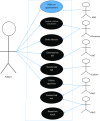The potential adoption benefits and challenges of LOINC codes in a laboratory department: a case study
- PMID: 29067166
- PMCID: PMC5636728
- DOI: 10.1007/s13755-017-0027-8
The potential adoption benefits and challenges of LOINC codes in a laboratory department: a case study
Abstract
Background: Logical Observation Identifiers Names and Codes (LOINC) are a standard for identifying and reporting laboratory investigations that were developed and are maintained by the Regenstrief Institute. LOINC codes have been adopted globally by hospitals, government agencies, laboratories, and research institutions. There are still many healthcare organizations, however, that have not adopted LOINC codes, including rural hospitals in low- and middle- income countries. Hence, organizations in these areas do not receive the benefits that accrue with the adoption of LOINC codes.
Methods: We conducted a literature search by utilizing PubMed, CINAHL, Google Scholar, ACM Digital Library, and the Biomed Central database to look for existing publications on the benefits and challenges of adopting LOINC. We selected and reviewed 16 publications and then conducted a case study via the following steps: (1) we brainstormed, discussed, analyzed, created and revised iteratively the patient's clinical encounter (outpatient or ambulatory settings) process within a laboratory department via utilizing a hypothetical patient; (2) we incorporated the work experience of one of the authors (CU) in a rural hospital laboratory department in Nigeria to break down the clinical encounter process into simpler and discrete steps and created a series of use cases for the process; (3) we then analyzed and summarized the potential usage of LOINC codes (clinically, administratively, and operationally) and the benefits and challenges of adopting LOINC codes in such settings by examining the use cases one by one.
Results: Based on the literature review, we noted that LOINC codes' ability to improve laboratory results' interoperability has been recognized broadly. LOINC-coded laboratory results can improve patients' safety due to their consistent meaning as well as the related reduction of duplicate lab tests, easier assessment of workloads in the laboratory departments, and accurate auditing of laboratory accounts. Further, the adoption of LOINC codes may motivate government agencies to upgrade hospitals' infrastructures, which could increase the possibility of international recognition of laboratory test results from those hospitals over the long term. Meanwhile, a lack of LOINC codes in paper format and a lack of LOINC codes experts are major challenges that may limit LOINC adoption.
Conclusion: In this paper, we intend to provide a snapshot of the possible usage of LOINC codes in rural hospitals in low- and middle-income countries via simpler and detailed use cases. Our analysis may aid policymakers to gain a deeper understanding of LOINC codes in regard to clinical, administrative, and operational aspect and to make better-informed decisions in regard to LOINC codes adoption. The use case analysis also can be used by information system designers and developers to reference workflow within a laboratory department. We recognize that this manuscript is only a case study and that the exact steps and workflows may vary in different laboratory departments; however, the core steps and main benefits should be consistent.
Keywords: Health policy; Hospital administration; Hospital-laboratories/standards; Logical Observation Identifiers Names and Codes (LOINC).
Figures
Similar articles
-
Logical Observation Identifiers Names and Codes for Laboratorians.Arch Pathol Lab Med. 2020 Feb;144(2):229-239. doi: 10.5858/arpa.2018-0477-RA. Epub 2019 Jun 20. Arch Pathol Lab Med. 2020. PMID: 31219342 Review.
-
LOINC, a universal standard for identifying laboratory observations: a 5-year update.Clin Chem. 2003 Apr;49(4):624-33. doi: 10.1373/49.4.624. Clin Chem. 2003. PMID: 12651816
-
Encoding laboratory testing data: case studies of the national implementation of HHS requirements and related standards in five laboratories.J Am Med Inform Assoc. 2022 Jul 12;29(8):1372-1380. doi: 10.1093/jamia/ocac072. J Am Med Inform Assoc. 2022. PMID: 35639494 Free PMC article.
-
Auditing consistency and usefulness of LOINC use among three large institutions - using version spaces for grouping LOINC codes.J Biomed Inform. 2012 Aug;45(4):658-66. doi: 10.1016/j.jbi.2012.01.008. Epub 2012 Jan 28. J Biomed Inform. 2012. PMID: 22306382 Free PMC article.
-
The LOINC Content Model and Its Limitations of Usage in the Laboratory Domain.Stud Health Technol Inform. 2020 Jun 16;270:437-442. doi: 10.3233/SHTI200198. Stud Health Technol Inform. 2020. PMID: 32570422 Review.
Cited by
-
New EHR certification requirements and their association with duplicate tests and images.J Am Med Inform Assoc. 2022 Jul 12;29(8):1391-1399. doi: 10.1093/jamia/ocac076. J Am Med Inform Assoc. 2022. PMID: 35640013 Free PMC article.
-
Semantic data interoperability, digital medicine, and e-health in infectious disease management: a review.Eur J Clin Microbiol Infect Dis. 2019 Jun;38(6):1023-1034. doi: 10.1007/s10096-019-03501-6. Epub 2019 Feb 15. Eur J Clin Microbiol Infect Dis. 2019. PMID: 30771124 Review.
-
Semantic enrichment of Pomeranian health study data using LOINC and WHO-FIC terminology mapping principles.JAMIA Open. 2025 Mar 6;8(2):ooaf010. doi: 10.1093/jamiaopen/ooaf010. eCollection 2025 Apr. JAMIA Open. 2025. PMID: 40059976 Free PMC article.
-
Ethical Considerations on Pediatric Genetic Testing Results in Electronic Health Records.Appl Clin Inform. 2020 Oct;11(5):755-763. doi: 10.1055/s-0040-1718753. Epub 2020 Nov 11. Appl Clin Inform. 2020. PMID: 33176390 Free PMC article.
-
Logical Observation Identifiers Names and Codes (LOINC®) Applied to Microbiology: A National Laboratory Mapping Experience in Taiwan.Diagnostics (Basel). 2021 Aug 28;11(9):1564. doi: 10.3390/diagnostics11091564. Diagnostics (Basel). 2021. PMID: 34573905 Free PMC article.
References
-
- “LOINC from Regenstrief.” https://loinc.org/. Accessed 08 May 2017.
-
- S. H. P. ONC, State HIE bright spots synthesis lab exchange. https://www.healthit.gov/sites/default/files/lab_exchange_bright_spots_s.... 2013.
-
- ONC. Health IT dashboard. http://dashboard.healthit.gov/index.php. 2015.
-
- WHO. WHO forum on health data standardization and interoperability. WHO, Geneva, 2012.
LinkOut - more resources
Full Text Sources
Other Literature Sources
Miscellaneous


